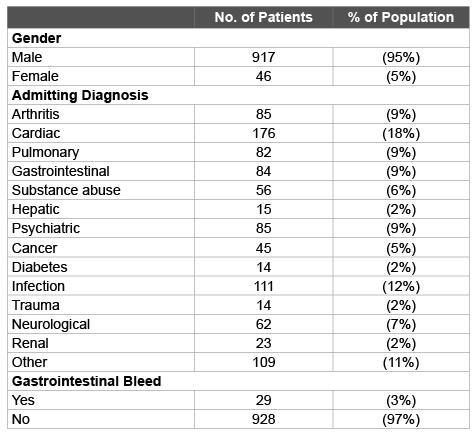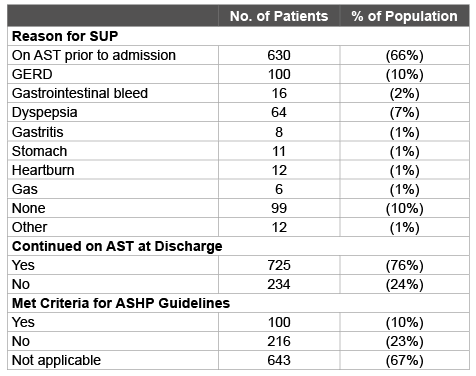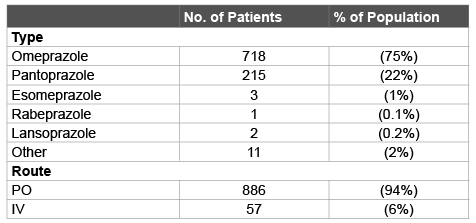
Table 1: Demographic characteristics of study population

Patrick Chen1 Nikhil Reddy2 Erin Loesch3 Sangeeta Agrawal1*
1Department of Internal Medicine, Division of Gastroenterology, Wright State University, Dayton VA Medical Center, Ohio, USA*Corresponding author: Sangeeta Agrawal, Department of Internal Medicine, Division of Gastroenterology, Wright State University, 1650 Stafford Springs Place Dayton, Ohio 45458, USA, Tel: (937) 268-2698; Fax: (937) 262-2154; E-mail: sagrawalgi@gmail.com
Background: The rise in proton pump inhibitor (PPI) usage has raised concerns pertaining to overutilization and an associated increase in costs. A medication use evaluation was performed to determine the appropriateness of stress ulcer prophylaxis for the Veterans Affairs (VA) hospital in Dayton, Ohio.
Methods: A retrospective chart review was performed on 963 patients admitted to the Dayton Veteran Affairs Medical Center (DVAMC), during a 4 month period, who were prescribed PPIs during hospital admission. The data recorded included patient demographics, PPI type, dose, route, frequency of administration, PPI started prior to admission, PPI upon discharge, reason for PPI, and if patient met criteria for stress ulcer prophylaxis (SUP) as determined by the American Society of Health-System Pharmacists (ASHP) guidelines published in 1999.
Results: Majority of the patients were prescribed omeprazole 20 mg orally daily. Ninety-seven percent of the patients were admitted to medical ward, 3% to ICU. Sixty-seven percent were on a PPI prior to admission and 75% were continued on a PPI at the time of discharge. For 65% of the patients, the reason for PPI use was continuation of an outpatient medication. SUP was documented in 32% of patients with only 10% meeting SUP criteria. The remaining 67% of patients were on prescription PPIs as an outpatient, prior to admission.
Conclusions: Inappropriate PPI administration was found in this retrospective review. This highlights the need for future cost-saving initiatives and collaborative team methods to increase patient safety by curbing inappropriate use of the PPI medication class.
Stress ulcer prophylaxis; Proton Pump Inhibitors
The number of prescriptions for proton pump inhibitors (PPI) over the past years has raised concerns pertaining to overutilization of this class of medications and an associated increase in costs [1,2]. PPIs are indicated for treatment of gastroesophageal reflux disease (GERD), peptic ulcer disease, and for stress ulcer prophylaxis (SUP). The current guidelines for SUP were published by the American Society of Health-System Pharmacists (ASHP) in 1999 to provide guidance for providers instituting SUP therapy in ICU patients [3]. These guidelines do not discuss the use of PPIs in non-ICU patients. Prior studies have demonstrated that providers have extrapolated these guidelines to patients in non-ICU settings, leading to increased amounts of inappropriate SUP administration. As the healthcare system continues to become more conscious of erroneous expenditures, there are concerns with the increasing number of patients being started on PPIs, incorrect dosages, lengths of therapy, and inappropriate continuation of PPIs upon discharge. Proton pump inhibitors should not be given to all hospitalized patients due to lack of proven clinical benefit in prevention of stress ulcers or gastrointestinal (GI) bleed, side effects, and increased costs [4,5]. A published review done by Heidelbaugh et al. [6] looking at inappropriate administration of SUP in patients admitted to a large university hospital revealed costs exceeding $100,000 for that year. Newly published literature reviewing adverse drug events of PPIs include the risk for infection, such as C. difficile and pneumonia, increased bone fractures, potential reduction of clopidogrel efficacy via cytochrome P450 (CYP) 2C19 inhibition, and B12 deficiency [7,8]. Despite ASHP’s guidelines being unchanged since 1999, subsequent studies have shown that providers administer SUP to patients on general medicine floors without an appropriate indication. A medication use evaluation was performed to determine the appropriateness of SUP for the Veterans Affairs hospital in Dayton, Ohio.
A retrospective chart review was performed on 963 patients admitted to the Dayton Veterans Affairs Medical Center (DVAMC) from January 1, 2015 through April 1, 2015 who were prescribed PPIs during hospital admission. For patients admitted multiple times during the 4 month course, only the initial admission was documented. Data collection focused on the assessment and plan portion of a fully documented history and physical, as well as discharge summaries, which specifically stated if a PPI was administered as SUP or GI prophylaxis. Patients who received PPIs for specific indications or appropriate treatment were excluded.
Patient data were obtained from the Computerized Patient Record System (CPRS). The data recorded included sex, age, weight, admitting unit, PPI, dose, route, frequency of administration, admitting diagnosis, PPI started prior to admission, PPI upon discharge, GI bleed during admission, documented reason for PPI, and if patient met criteria for SUP. The ASHP guidelines were used to determine if patients met SUP criteria.
Statistical analysis was performed using Microsoft Excel software. Data were entered into the program and the statistics were calculated for mean, standard deviation, and median.
The study included far more males than females because of the predominantly male population in our facility. The mean age was 65 years and the most common PPI prescribed was omeprazole 20 mg capsule once daily. Only 6% of patients were prescribed a PPI via intravenous route, with pantoprazole (40 mg twice daily) being the most common medication. The vast majority of the patients were admitted to the medical ward, while only 3% were admitted to the ICU. Sixty-seven percent of the patients were on a PPI prior to admission and 75% of patients were continued on a PPI at the time of discharge. Only 3% of the sample had a documented GI bleed during the admission. For 65% of the patients, the documented reason for PPI use was continuation of an outpatient medication upon admission, followed by 10% for a GERD indication, while 10% of patients were without any documentation. SUP was documented in 32% of patients with 10% meeting SUP criteria; Twenty-two percent did not meet SUP criteria. The remaining 67% of patients were excluded because they were on a prescription PPI as an outpatient, prior to admission (Tables 1-3).

Table 1: Demographic characteristics of study population

Table 2: Data for SUP SUP=Stress Ulcer Prophylaxis, AST = Acid Suppression Therapy, ASHP=American Society of Health-System Pharmacists

Table 3: Type and route of proton pump inhibitors PO=Oral, IV=Intravenous
Inappropriate PPI administration was found in one hospital in this retrospective review. There were approximately twice as many patients who did not meet SUP criteria compared to patients with appropriate SUP criteria. This raises concerns because the ASHP guidelines have not been updated since 1999, and PPIs are still being inappropriately administered leading to increased healthcare costs and adverse drug reactions.
A thoughtful strategy to decrease the rate of inappropriate PPI administration could be an implementation of quality assurance measures instituted by pharmacists, who may help educate providers of the appropriate, although outdated, SUP guidelines. Measures taken to limit inappropriate PPI administration will decrease costs in both the inpatient and outpatient settings. The VA hospital system is constantly under scrutiny to run efficiently while maintaining patient safety and this is one identifiable area where concentrated efforts should be focused to improve outcomes. The VA network is reviewing chronic PPI use throughout the Ohio-based facilities to assess the appropriateness of medication usage in order to decrease side effects and costs. We are collaborating with our pharmacy department to educate providers and patients about the potential risks of long term PPI use. There is a potential for further controls to be instituted, such as a hard stop in the electronic medical record, to require providers to validate the SUP indication when placing an inpatient PPI order. This endeavor will become increasingly important as new SUP guidelines are anticipated from ASHP in the spring of 2016. Additionally, with the adoption of ICD-10 coding, more detailed documentation and justification should be required to order SUP.
The strengths of the study include a sample size of 963 patients over a 4 month period with complete information collected from inpatient and outpatient records at DVAMC. VA hospitals are known to be cost conscious due to a majority of the health care costs coming directly from government funding, thus unnecessary expenditure is heavily scrutinized. Inappropriate SUP administration likely stems from several reasons: a) outdated ASHP guidelines, b) lack of provider education about the appropriate length of PPI use, c) lack of knowledge about the side effects of long term PPI therapy among providers and patients. Also, the vast majority of patients were admitted to a medical floor, as opposed to the ICU, that allowed for greater odds of finding inappropriate SUP administration. Since this study is completed during the same year as the anticipated new ASHP guidelines we look forward to the new guidelines and educating providers accordingly. A limitation of this study is that it was performed in a retrospective fashion. Also, there is only data collected from one hospital site, with an overwhelming population of males.
This retrospective review highlights the inappropriate overutilization of PPIs in hospitalized patients. Educating providers will be most useful in a multidisciplinary team approach, in conjunction with implementation of a planned PPI step-down protocol to attempt to decrease the use of this over prescribed class of medication. The 1999 ASHP guidelines are antiquated and there is a need to revisit PPI usage in light of subsequent published literature calling into question long term safety of the PPI medication class. However, with this data, it is clear that concentrated efforts to avoid prescribing PPIs during acute care admissions are warranted and may be an area of future and more focused collaboration between clinical pharmacists and providers.
Download Provisional PDF Here
Article Type: Research Article
Citation: Chen P, Reddy N, Loesch E, Agrawal S (2016) Appropriateness of Stress Ulcer Prophylaxis in Hospitalized Patients. J Gastric Disord Ther 2(3): doi http://dx.doi.org/10.16966/2381-8689.122
Copyright: © 2016 Chen P, et al. This is an open-access article distributed under the terms of the Creative Commons Attribution License, which permits unrestricted use, distribution, and reproduction in any medium, provided the original author and source are credited.
Publication history:
All Sci Forschen Journals are Open Access